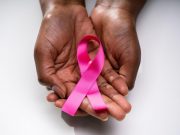Tag: Cancer: Breast
Living in Disadvantaged Neighborhood Shortens Breast Cancer Survival
Findings seen after adjusting for sociodemographics, comorbidity, breast cancer risk factor, access to care, tumor, and guideline-concordant treatment
Race-Adapted Starting Ages Suggested for Breast Cancer Screening
Breast cancer mortality higher for Black women and lower for American Indian or Alaska Native, Hispanic, and Asian or Pacific Islanders age 40 to 49 years
Study Looks at Impact of Depression on Breast Cancer Outcomes
Patients with depression only in the prediagnosis period less likely to receive guideline-recommended treatment, have worse survival
Breast-Conservation Therapy Feasible in Multiple Ipsilateral Breast Cancer
Estimated five-year cumulative incidence of local recurrence 3.1 percent for women undergoing BCT and adjuvant radiation
ChatGPT Mostly Accurate for Breast Cancer Prevention, Screening Questions
Responses were graded by fellowship-trained breast radiologists
Targeted Ultrasound Alone Found to Be Accurate Breast Imaging Modality
Ultrasound sensitivity and specificity were 98.5 and 90.8 percent among women aged 30 years or older with focal breast complaints
Slight Increase in Breast Cancer Risk Seen With Progestogen-Only Contraceptives
Increased relative risks noted for current or recent use of oral, injected, implanted, IUD progestogen-only contraceptives
Older Women Still at Risk for Cancer With BRCA1/2 Mutations
Risk reduction surgeries before age 50 years substantially cut later cancer risk for those with genetic risk
Geographical, Racial/Ethnic Differences Seen for Triple-Negative Breast Cancer
Even within a racial/ethnic group, state-specific variation was substantial
Anatomic Stage, Receptor Status Influence Timing of Breast Cancer Recurrence
Risk for recurrence was highest and occurred earliest for ER-negative/PR-negative/Her2neu-negative tumors














